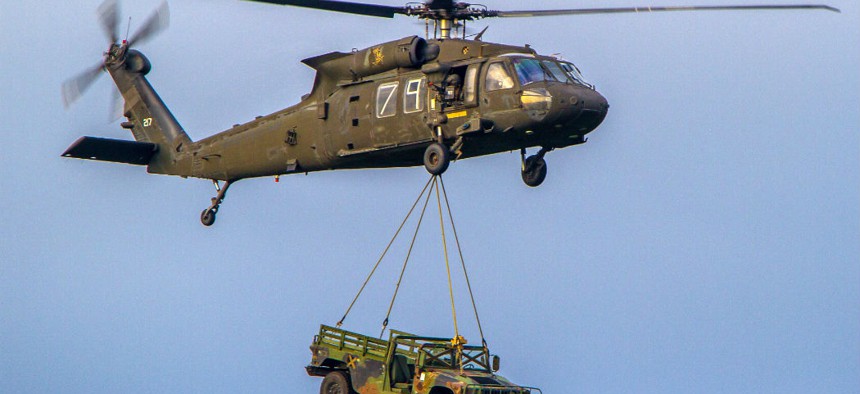Army plans to deploy lighter weight, helicopter sling loaded, HMMWV mounted WIN-T
Using faster processing power and other advances, the Army is testing a lightweight version of WIN-T Inc. 2 able to mount onto HMMWVs and sling load beneath helicopters.
The Army plans to deploy a lighter-weight version of its Warfighter Information Network – Tactical on helicopter sling-loaded HMMWVs to leverage ongoing upgrades to the service’s mobile satcom and radio network.
During a currently ongoing Army Network Integration Evaluation (NIE) at White Sands Missile Range, N.M., the service is evaluating HMMWVs operating beneath CH-47 Chinook cargo helicopters equipped with WIN-T Inc. 2.
Leveraging faster processing power and a reduced hardware footprint, a smaller amount of WIN-T Inc. 2 equipment can perform the same networking functions now performed by larger components.
“WIN-T capabilities, using smaller system components and innovative vehicle integration methods, are now mounted on lightweight HMMWV platforms instead of larger tactical trucks,” said Paul Mehney, director of communications for Program Executive Office, C3T.
Systems under test at the ongoing NIE 17.2 include both WIN-T Inc. 1 and Inc. 2. Assessments include increased range and bandwidth along with a newly configured WIN-T Inc. 2 called Tactical Communications Node-Lite (TCN-L) and Network Operations and Security Center-Lite (NOSC-L), enhancements designed to enable satcom and radio-enabled mission-command-on-the-move.
If the test is successful, the Army plans to field the lighter-weight WIN-T Inc. 2 to light infantry units in combat to enable faster deployment, improved connectivity and rapid battlefield mobility.
“In support of expeditionary, quick-reaction and air assault mission requirements, the Army has integrated these WIN-T Inc. 2 configurations onto HMMWVs that can be sling-loaded by a helicopter across the battlefield or rolled onto a C-130 aircraft, providing significantly increased agility and operational flexibility,” Mehney added.
Previously, the Tactical Communications Node (TCN) and Network Operations and Security Center (NOSC) were integrated on five-ton Family of Medium Tactical Vehicles to meet the force protection operational demands of past COIN operations.
The WIN-T communications technology is designed to connect fixed locations and moving vehicles to mission command systems such as mapping, video, intelligence assets, force-tracking applications and other command post functions. WIN-T Inc. 1 connects fixed locations and the now-emerging WIN-T Inc. 2 enables mission command on-the-move by building the satcom network into vehicles.
According to Army statements, WIN-T is a critical element of C4ISR modernization because existing and emerging threats require forces to spread out across wider swaths of terrain, and they will need access to extended-reach secure communications.
The mission command on-the-move enabled by WIN-T Inc. 2 is an increasingly vital technology in need of proper management and maintenance, Army officials said.
“As the Army moves to a more expeditionary force, dispersed over ever-increasing distances, managing and defending this sophisticated network (WIN-T) becomes a crucial element in achieving mission success,” an Army statement said.
General Dynamics Mission Systems developers emphasize that common IP protocol engineering standards will continue to allow upgrades and fixes.
WIN-T Inc. 2 has been fielded to at least 16 Brigade Combat Teams and has performed well in combat during ongoing ground wars.





